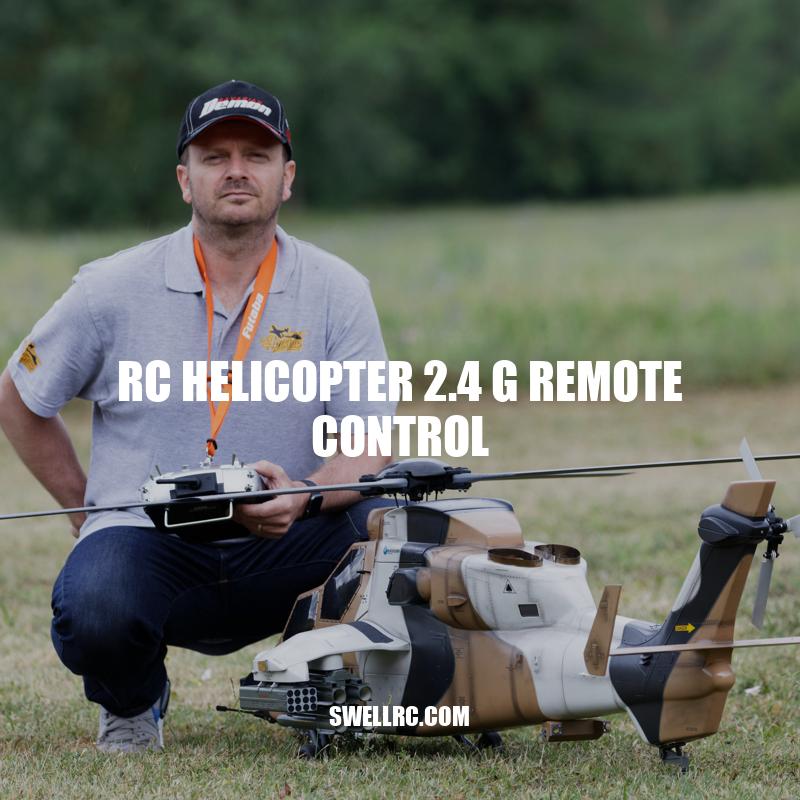Mastering RC Helicopters with 2.4G Remote Control: A Comprehensive Guide
RC helicopters have become an increasingly popular hobby amongst enthusiasts. These hobbyists are hooked to the feeling of maneuvering a helicopter in the air and the thrill of performing stunts. Remote control helicopters bring the excitement of flight to enthusiasts without the steep learning curve associated with traditional piloting. Remote-controlled helicopters use sophisticated technology to control the helicopter’s movement using a radio transmitter and receiver. In recent years, the 2.4G remote control technology has been the most popular way of controlling these RC helicopters. The 2.4G technology has improved the range and reliability of the remote controlled helicopter, making it more accessible to people than ever before. In this article, we will provide an in-depth discussion on RC helicopter 2.4G remote controls, their features, advantages, and provide tips on how you can select and use them. Whether you are a seasoned RC pilot or just getting started, this article will be helpful in providing you with the necessary knowledge to maximize your enjoyment of RC helicopter 2.4G remote controls.
What is RC Helicopter 2.4G Remote Control?
An RC helicopter 2.4G remote control is essentially a radio-controlled helicopter that uses 2.4 gigahertz frequency to transmit control inputs from the remote transmitter to the receiver in the helicopter. This type of remote control has become extremely popular because it is more reliable than other types of radio frequencies used in the past. Here are some additional key aspects of RC helicopter 2.4G remote control:
- They come in a range of different sizes, from micro helicopters that fit in the palm of your hand to larger models that can carry a small camera.
- They can be used indoors or outdoors depending on their size and features.
- They typically have a flight time of between 5-10 minutes, but this can vary depending on the model and battery size.
- They are powered by rechargeable batteries, which require a specific charger to prevent overcharging or undercharging the battery.
- Many models come equipped with gyroscopes to help stabilize the helicopter during flight.
If you are new to the world of RC helicopter 2.4G remote control, you might find it overwhelming to choose the best model for your needs. Several factors come into play when selecting an RC helicopter 2.4G remote control, such as size, cost, and flying experience. Fortunately, several websites and online retailers provide information and reviews on different models, making it easier to choose the right one according to your preferences.
How does a remote control helicopter work?
A remote control helicopter works by using radio controls to remotely control its movements. A 4-channel transmitter is used, with two sticks that control the helicopter’s pitch, yaw, throttle, and roll movements. For more information on radio control, visit the Wikipedia page on Radio Control. If you’re interested in purchasing a remote control helicopter, check out online retailers like Amazon or hobby shops like HobbyKing.
RC helicopter 2.4G remote control offers several benefits that make it a popular hobby among enthusiasts. Some of its key advantages include:
- Increased range: The 2.4G remote control frequency allows the helicopter to fly farther away from the transmitter without losing signal.
- Stability control: Many models come equipped with built-in gyroscopes, which help stabilize the helicopter during flight and improve manoeuvrability.
- Reduced interference: The 2.4G signal experiences less interference from other devices, reducing the likelihood of losing control of the helicopter.
- Multiple helicopters can be flown at the same time: Since the 2.4G frequency does not overlap with other frequencies used in RC helicopters, several helicopters can be flown at the same time without signal interference.
- Digital controls: The 2.4G signal allows for digital control of the helicopter, providing a more responsive and smoother flight experience.
Interestingly, some advanced models are also capable of performing aerobatic stunts and flips, making them even more exciting to fly. Some popular models include the Syma S107G, E-flite Blade 70S, and the Blade mSR S.
For those interested in purchasing an RC helicopter 2.4G remote control, there are several reliable sources online for finding high-quality models. Some popular websites include Amazon, Banggood and HobbyKing. Below is a table summarizing some of the best RC helicopters 2.4G remote control models on the market:
| Model | Price | Features |
|---|---|---|
| Syma S107G | $29.99 | Indoor/outdoor use, LED lights, gyroscopic control |
| E-flite Blade 70S | $79.99 | 3D aerobatics, SAFE technology, beginner-friendly |
| Blade mSR S | $129.99 | Brushless motor, advanced aerobatic features, stability modes |
Are RC helicopters better than drones?
RC helicopters and drones both have their advantages and disadvantages. RC helicopters tend to be cheaper, but drones offer more advanced features such as better battery life and the ability to excel with aerial photography. Drones are also easier to control than RC helicopters. Ultimately, the choice between the two depends on the user’s needs and preferences. For more information on RC helicopters and drones, visit websites such as HobbyTron and DJI.
How to Choose the Best RC Helicopter 2.4G Remote Control
Choosing the right RC helicopter 2.4G remote control can be overwhelming, considering the wide range of options available. Here are a few key factors to consider when making a purchase:
- Skill level: Consider your expertise level, whether you’re a beginner or an advanced pilot. Beginner-friendly models often come with safety features such as automatic altitude adjustment and headless mode.
- Flight time: Depending on your needs, you may consider purchasing a model with a longer battery life, so you can enjoy flying for longer periods.
- Durability: Look for models made with durable materials that can withstand crashes and collisions.
- Size: Decide whether you prefer a smaller indoor model or a larger outdoor one.
- Price: Set a budget and look for models within your price range.
- Features: Look for models with features that match your preferences, such as camera capabilities, LED lights, and remote control distance.
Additionally, check product reviews and ratings to see what other users have to say about the RC helicopter models you’re interested in. Some popular models to consider include the Syma S107G, E-flite Blade 70S, and the Blade mSR S.
Websites such as Amazon, Banggood, and HobbyKing offer a vast selection of RC helicopter 2.4G remote control models, along with customer reviews and ratings. You can also consider purchasing directly from the manufacturer’s website for more options and promotions.
How to choose a motor for RC helicopter?
When choosing a motor for RC helicopter, it is important to consider the weight of the heli and the type of flight you want to achieve. A good rule of thumb is that you need around 250-300 watts per pound for 3d flight. For example, if your heli weighs 10lbs, then a motor that can do 3000 watts will work great. You can find suitable motors on websites such as HobbyKing or Amazon.
How to Fly an RC Helicopter 2.4G Remote Control
Flying an RC helicopter 2.4G remote control can be challenging at first, but with practice, it can become a fun and rewarding hobby. Here are some tips to help you get started:
- Find an open area: Look for a spacious and open area free of obstacles, people, and buildings, where you can fly without any distractions and interferences.
- Start slow: Begin with slow and easy movements to get used to the controls. Focus on keeping the helicopter stable and balanced in the air.
- Learn the controls: Understand how each control on the remote control affects the helicopter’s movement. The left joystick controls altitude and direction, while the right joystick controls forward, backward, left, and right movement.
- Practice hovering: Try hovering the helicopter in the air using the left joystick. This will help you establish full control of the helicopter’s movements.
- Fly in different directions: Practice moving the helicopter in different directions, such as forward, backward, left, and right.
- Experiment with more complex movements: As you become more comfortable, try different movements, such as flips, rolls, and sharp turns.
- Monitor battery life: Keep track of the battery life and land the helicopter before it runs out of power.
- Take safety precautions: Always wear safety goggles and consider investing in propeller guards to prevent damage and injuries.
It’s essential to be patient and persistent when learning to fly an RC helicopter 2.4G remote control. Ensure you practice as much as possible to improve your skills and maximize your fun. Additionally, refer to user manuals and online tutorials for more information and guidance.
How do you land an RC helicopter?
To land an RC helicopter, you should start by reducing the throttle slowly until it touches the ground. Ensure that the landing surface is flat and clear of obstacles. Also, it’s essential to practice hovering skills before attempting to land the helicopter as it requires stability and control. You can find various landing tutorials on YouTube, including this video from RC Helicopter Fun channel: https://www.youtube.com/watch?v=jcXQxcGqZ4s.
Maintenance Tips for RC Helicopter 2.4G Remote Control
Taking care of your RC helicopter 2.4G remote control is crucial to ensure its longevity and efficient performance. Here are some maintenance tips to keep your remote control helicopter in peak condition:
- Keep it clean: Dust and debris can affect the helicopter’s performance, so clean it after each flight using a good-quality cloth and a cleaning solution designed for electronics.
- Charge the battery: Ensure the battery is fully charged before flying, and avoid leaving a discharged battery for an extended period as it might lead to permanent damage.
- Store it properly: Store the helicopter in a dry, cool, and safe place to prevent any damage or accidents. Use the original packaging or a protective storage case if available.
- Check for any damage: After each flight, check for any damage or signs of wear and tear. Replace or repair damaged or worn-out parts as soon as possible.
- Lubricate moving parts: Proper lubrication of moving parts, such as the rotor blades and gears, is vital to prevent friction and keep them running smoothly.
- Follow user manuals: Refer to user manuals for specific instructions and maintenance schedules suggested by the manufacturer.
Regular maintenance of your RC helicopter 2.4G remote control can help prolong its lifespan and prevent costly repairs or replacements. If you need any assistance in maintaining or repairing your helicopter, consider contacting professional technicians or online resources like RC hobbyist forums or websites for guidance.
How long does it take to learn to fly an RC helicopter?
According to the provided information, it can take anywhere from 10 days to several months to learn how to fly an RC helicopter, depending on your natural abilities and how much time you spend practicing. There are various websites and products available that offer RC helicopter flying lessons, which may also affect the duration of your learning process.
Conclusion
In conclusion, RC helicopters bring a lot of excitement and entertainment, especially with the advancement of remote control technology. The RC helicopter 2.4G remote control is an improvement that has significantly increased the performance and range of these air vehicles. In this article, we have highlighted the advantages of using an RC helicopter 2.4G remote control, steps for choosing and flying an RC helicopter 2.4G remote control, and maintenance tips to prolong its lifespan. With these tips and guidelines, you should be able to choose, fly and maintain your remote control helicopter without any challenges. Remember to take necessary safety precautions, follow user manuals and get professional help if needed. RC helicopters offer endless opportunities for fun and entertainment; don’t hesitate to explore them.



